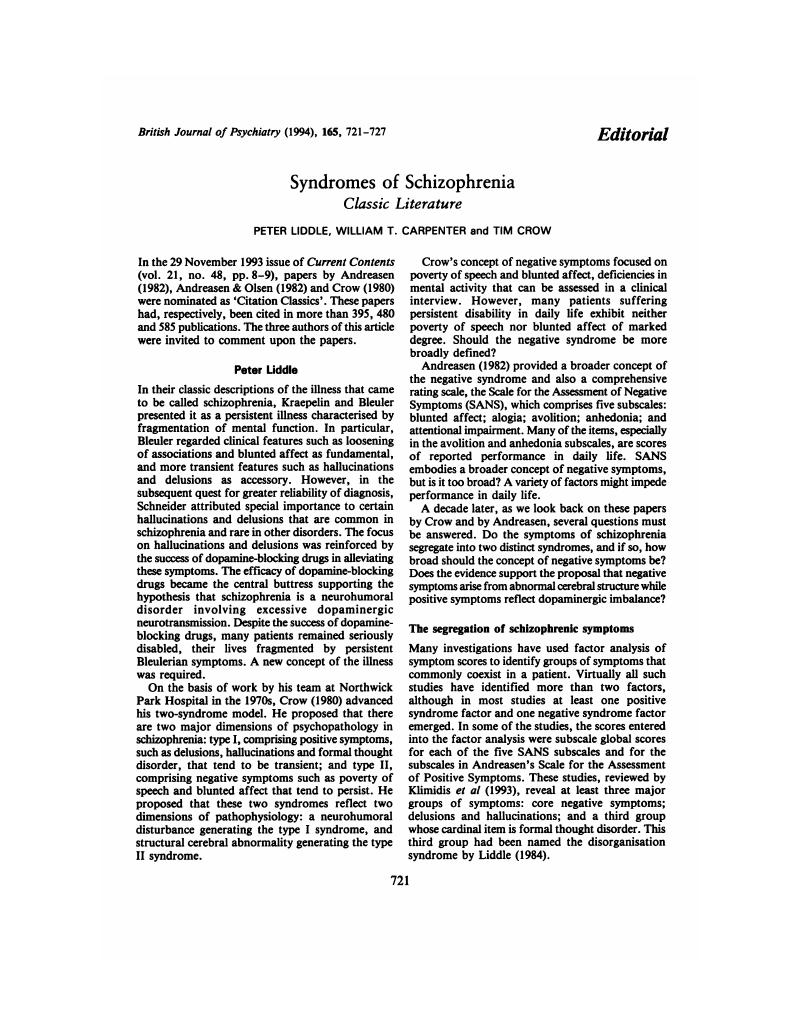Crossref Citations
This article has been cited by the following publications. This list is generated based on data provided by Crossref.
McGorry, P. D.
McFarlane, C.
Patton, G. C.
Bell, R.
Hibbert, M. E.
Jackson, H. J.
and
Bowes, G.
1995.
The prevalence of prodromal features of schizophrenia in adolescence: a preliminary survey.
Acta Psychiatrica Scandinavica,
Vol. 92,
Issue. 4,
p.
241.
1995.
Studies of the course and outcome of schizophrenia in later life.
Psychiatric Services,
Vol. 46,
Issue. 9,
p.
877.
Loas, Gwenole
Boyer, Patrice
and
Legrand, Alain
1996.
Anhedonia and negative symptomatology in chronic schizophrenia.
Comprehensive Psychiatry,
Vol. 37,
Issue. 1,
p.
5.
Copolov, David
1996.
Diagnosis and phenomenology of schizophrenia and related disorders.
Current Opinion in Psychiatry,
Vol. 9,
Issue. 1,
p.
63.
Trabert, Wolfgang
Rösler, M.
Pülschen, D.
and
Lamberty, H.-M.
1996.
Befunderhebung in der Psychiatrie: Lebensqualität, Negativsymptomatik und andere aktuelle Entwicklungen.
p.
195.
Cassano, GB
Ciapparelli, A
and
Villa, M
1997.
Clozapine as a treatment tool: only in resistant schizophrenic patients?.
European Psychiatry,
Vol. 12,
Issue. S5,
p.
347s.
Salokangas, R. K. R.
1997.
Structure of schizophrenic symptomatology and its changes over time: prospective factor‐analytical study.
Acta Psychiatrica Scandinavica,
Vol. 95,
Issue. 1,
p.
32.
Fear, CF
McMonagle, T
and
Healy, D
1998.
Delusional disorders: boundaries of a concept.
European Psychiatry,
Vol. 13,
Issue. 6,
p.
322.
Lidow, M.S.
Williams, G.V.
and
Goldman-Rakic, P.S.
1998.
The cerebral cortex: a case for a common site of action of antipsychotics.
Trends in Pharmacological Sciences,
Vol. 19,
Issue. 4,
p.
136.
Fear, C. F.
McMonagle, T.
and
Healy, D.
1999.
Trastornos delirantes: límites de un concepto.
European psychiatry (Ed. Española),
Vol. 6,
Issue. 2,
p.
130.
Elkis, Helio
1999.
Fatores de impacto de publicações psiquiátricas e produtividade científica.
Revista Brasileira de Psiquiatria,
Vol. 21,
Issue. 4,
p.
231.
SMITH, THOMAS E.
HULL, JAMES W.
GOODMAN, MARIANNE
HEDAYAT-HARRIS, ANDIEA
WILLSON, DEBORAH F.
ISRAEL, LYSSA M.
and
MUNICH, RICHARD L.
1999.
The Relative Influences of Symptoms, Insight, and Neurocognition on Social Adjustment in Schizophrenia and Schizoaffective Disorder.
The Journal of Nervous & Mental Disease,
Vol. 187,
Issue. 2,
p.
102.
Ngan, Elton T.C
and
Liddle, Peter F
2000.
Reaction time, symptom profiles and course of illness in schizophrenia.
Schizophrenia Research,
Vol. 46,
Issue. 2-3,
p.
195.
Marengo, Joanne
Harrow, Martin
Herbener, Ellen S.
and
Sands, James
2000.
A prospective longitudinal 10-year study of schizophrenia's three major factors and depression.
Psychiatry Research,
Vol. 97,
Issue. 1,
p.
61.
Cohen, Carl I.
Cohen, Gene D.
Blank, Karen
Gaitz, Charles
Katz, Ira R.
Leuchter, Andrew
Maletta, Gabe
Meyers, Barnett
Sakauye, Kenneth
and
Shamoian, Charles
2000.
Schizophrenia and Older Adults: An Overview: Directions for Research and Policy.
The American Journal of Geriatric Psychiatry,
Vol. 8,
Issue. 1,
p.
19.
Menon, V.
Anagnoson, R.T.
Mathalon, D.H.
Glover, G.H.
and
Pfefferbaum, A.
2001.
Functional Neuroanatomy of Auditory Working Memory in Schizophrenia: Relation to Positive and Negative Symptoms.
NeuroImage,
Vol. 13,
Issue. 3,
p.
433.
Moritz, S.
Andresen, B.
Jacobsen, D.
Mersmann, K.
Wilke, U.
Lambert, M.
Naber, D.
and
Krausz, M.
2001.
Neuropsychological correlates of schizophrenic syndromes in patients treated with atypical neuroleptics.
European Psychiatry,
Vol. 16,
Issue. 6,
p.
354.
Sass, Louis A.
2001.
Schizophrenia, Modernism, and the "Creative Imagination": On Creativity and Psychopathology.
Creativity Research Journal,
Vol. 13,
Issue. 1,
p.
55.
Kapur, Shitij
and
Remington, Gary
2001.
Atypical Antipsychotics: New Directions and New Challenges in the Treatment of Schizophrenia.
Annual Review of Medicine,
Vol. 52,
Issue. 1,
p.
503.
Fowles, Don C.
2002.
Comprehensive Handbook of Psychopathology.
p.
85.




eLetters
No eLetters have been published for this article.